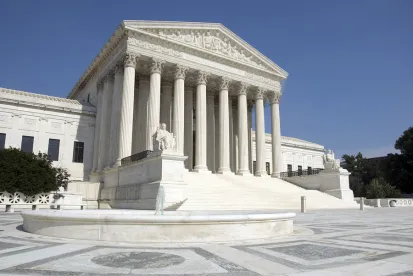ERISA plan fiduciaries charged with responsibility for selecting, monitoring or removing plan investment options should pay close attention to the U.S. Supreme Court’s recent ruling in Tibble v. Edison Intl., 135 S. Ct. 1823 (2015). In that decision, the Court ruled that ERISA’s duty of prudence involves “a continuing duty to monitor investments and remove imprudent ones.” Although the Court did not elaborate on what it viewed to be the scope of an ERISA plan fiduciary’s duty to monitor, the plaintiffs’ bar is already seizing on the ruling as a potential basis for asserting new claims based on a failure to monitor prudently plan investments and other plan functions. Thus, plan fiduciaries are advised to establish a thoughtful and appropriate procedure for monitoring plan investment options, to diligently follow that procedure when monitoring plan investment options, and to make and preserve a written record reflecting that they followed their procedure in every regard. Taking these steps will put fiduciaries in a favorable position should emboldened plan participants file lawsuits challenging whether fiduciaries fulfilled their duty to monitor plan investment options based on the perceived plaintiff-friendly Tibble ruling.
Background
In 2007, plaintiff Glenn Tibble on behalf of himself and a putative class of participants and beneficiaries in the Edison 401(k) Savings Plan (Plan) filed a lawsuit asserting a variety of fiduciary breach claims associated with the selection, monitoring and removal of certain investment options in the Plan that had been available since as early as 1999. The claims included assertions that the investment funds selected were: (i) “retail mutual funds” and, as such, allegedly charged higher fees than institutional funds that were available instead; (ii) in the wrong economic sector; and (iii) money market as opposed to “stable value” funds. Plaintiffs also claimed, among other things, that the Plan’s company stock fund was imprudently managed because it was a “unitized” fund, rather than a direct ownership fund.
The district court ruled that plaintiffs’ claims related to the investment options that were added to the Plan’s menu of investment options in 1999 were untimely because they had been added more than six years prior to the filing of the complaint.
The Ninth Circuit affirmed and held that the statute of limitations for a fiduciary breach claim alleging that the Plan’s investment menu was designed “imprudently” begins to run from the “act of designating an investment for inclusion” in the Plan, not from the date fiduciaries of the Plan failed to remove the investment option or the date that the alleged imprudent option remained in the Plan. In so holding, the Ninth Circuit concluded that plaintiffs could not establish that there were “changed circumstances engendering a new breach,” such that a new duty to act prudently with respect to the challenged investment options, and thereby a new statute of limitations period, had arisen. The Court further explained that if the continued offering of a plan investment option, without more, started a new statute of limitations period, it would render the statute of limitations “meaningless” and potentially expose current fiduciaries to claims based on actions that occurred many years ago by their predecessors.
The Supreme Court’s Decision
The Supreme Court vacated the Ninth Circuit’s decision. First, it held that the Ninth Circuit failed to recognize that under trust law a fiduciary is required to conduct a “regular review of its investments with the nature and timing of the review contingent on the circumstances.” The Court explained that this duty exists separate and apart from a fiduciary’s duty to exercise prudence in selecting investments options in the first place.
Second, the Court ruled that a participant may timely allege that a fiduciary breached the duty of prudence by failing to properly monitor investments and remove imprudent ones, provided that this alleged breach occurred within six years of suit.
Notably, the Court remanded the issue of the scope of the continued duty to monitor plan investments to the lower court to consider whether the Plan fiduciaries breached their duties, “recognizing the importance of analogous trust law.” While the Court did not specify the scope of the duty to monitor, some inferences may be drawn from the Court’s observations about trust law required. The Court, citing trust law, commented that a fiduciary must “systematic[ally] condside[r] all the investments of the trust at regular intervals” to ensure their continued appropriateness for the trust. The trust law authorities cited by the Court further suggest that the level of diligence required must be “reasonable” and “appropriate” to the particular investments.
Our View
The Court’s ruling that ERISA plan fiduciaries have a continuing duty to monitor plan investments is unremarkable it its own right. However, while the Court declined to expressly state how this duty is satisfied, it did provide some clues on where to find some guidance. For starters, the Court stated that “the nature and timing of the review [is] contingent on the circumstances.” It also stated that the Ninth Circuit, in evaluating whether the Plan fiduciaries satisfied their duty of prudence, should recognize the “importance of analogous trust law.” In doing so, the Court signaled that the monitoring of plan investments must be regular, systematic and reasonable based on the particular investments at issue.
Plan fiduciaries should take proactive measures to ensure that the monitoring of plan investment options is regular, systematic and reasonable. “Best practices” militate in favor of plan fiduciaries adopting a procedure for the regular monitoring of plan investment options, closely following that procedure, and making a written record of the implementation of and the adherence to that procedure. While the results of investment decisions on behalf of the plan do not have to be “correct,” the process in place must be prudent and diligently followed. As long as fiduciaries have engaged in prudent process with respect to monitoring investment options (that was clearly regular, systematic and reasonable based on the plan’s written record), they ought to have a meritorious defense to a breach of fiduciary duty claim.
Also, a good rule of thumb for plan fiduciaries to determine what is “reasonable” is to compare their plan’s practices to what other plans of similar size and nature are doing by way of monitoring plan investment options. By doing this, one can gauge the “industry standard,” which will aid in a legal defense in the event there is future litigation concerning the monitoring fiduciaries have undertaken.
Will Tibble cause the ERISA plaintiffs’ bar to initiate widespread class action lawsuits challenging plan fiduciaries’ alleged lack of continuous monitoring of plan investments? Some have already opined that the Court’s decision has paved the way for increased class litigation and called the decision a “game-changer” for the plaintiffs’ bar. That is not necessarily the case. Plaintiffs will have to do more than simply plead that the plan fiduciaries failed, within six years of filing suit, to prudently monitor an investment option. Rather, as the Supreme Court articulated many years ago, a plaintiff must be able to plead a plausible claim. That is, plaintiffs will have to plead “enough factual matter” to “nudge their claims across the line from conceivable to plausible.” To withstand a motion to dismiss, plaintiffs will not only have to allege that plan fiduciaries had a continuous duty to monitor, but also plead enough facts to suggest that there was in fact a failure to monitor and that plaintiffs (or the plan) suffered actual harm as a result of the alleged failure to monitor. However, if plan fiduciaries do find themselves as defendants in a lawsuit for allegedly failing to prudently monitor plan investment options, they will be well-served to have remembered the Tibble ruling and taken the measures discussed above.



 />i
/>i

